Sloped garden design is all about making the most of your yard’s natural incline while creating a visually appealing and functional space. With a few creative strategies, you can turn those awkward slopes into charming terraces or lush tiered gardens. Let’s uncover some fun ideas to enhance your outdoor space, making it both practical and beautiful!
Creating Pathways and Access Points
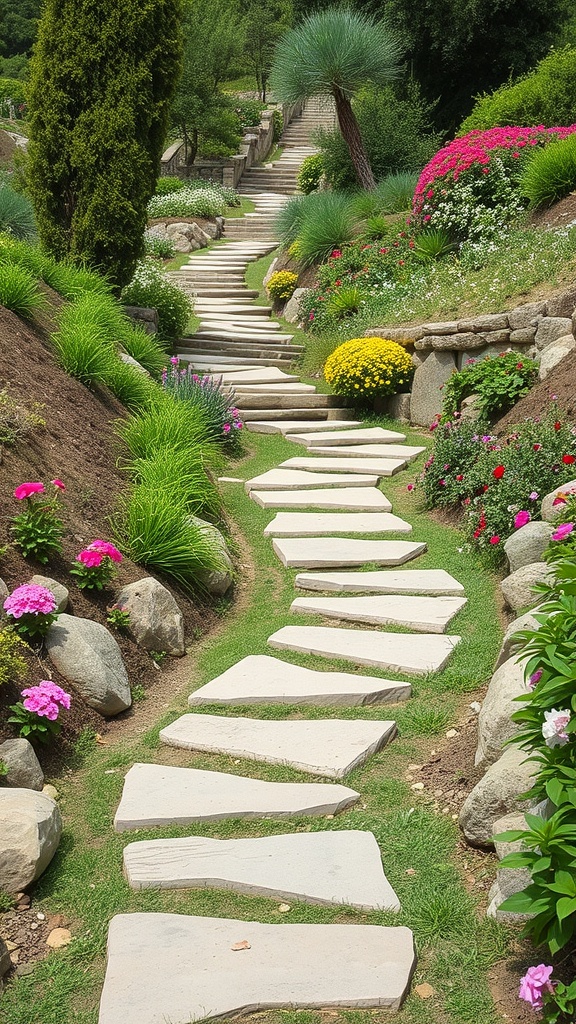
Creating pathways in a sloped garden is key to making the space functional and inviting. The image shows a beautifully designed pathway made of stone slabs, winding through vibrant flowers and lush greenery. This design not only enhances the visual appeal but also provides a clear route for walking. The gentle slope of the garden is complemented by the pathway, making it easy to navigate without any steep climbs. Using natural materials like stone helps the pathway blend seamlessly with the garden’s environment, adding to its charm. Access points are essential for maintenance and enjoyment, allowing you to reach different areas of the garden with ease. Whether it’s for a casual stroll or tending to plants, well-placed pathways make all the difference in a sloped garden design.
Incorporating Retaining Walls

Retaining walls are a fantastic way to manage sloped gardens. They help create flat areas for planting and make the space more usable. The image shows a beautifully designed sloped garden with stone retaining walls that add both function and style.
The walls in the picture are made from natural stone, giving a rustic feel. They not only hold back soil but also create distinct levels in the garden. This layering can enhance the visual appeal, making the garden look more organized and inviting.
Incorporating plants along the walls adds life and color. The lush greenery and vibrant flowers in the image show how plants can thrive in such a setup. Choosing the right plants is key; some may prefer the extra drainage that a wall provides, while others may need more moisture.
Overall, retaining walls can transform a challenging slope into a stunning garden space. They offer a practical solution while allowing for creativity in design. Whether you want a modern look or something more traditional, there’s a style of retaining wall that can fit your vision.
Designing for Drainage and Erosion Control
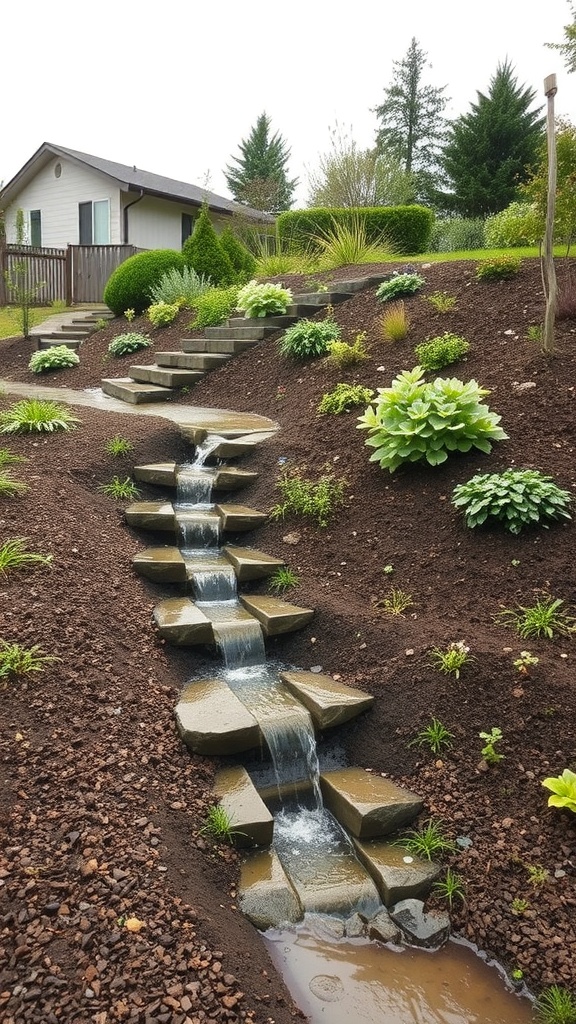
When designing a sloped garden, drainage and erosion control are key. The image shows a beautiful example of how to manage water flow effectively. Notice the stone steps that guide water down the slope, preventing erosion while adding charm to the landscape.
Incorporating a water feature like this not only looks great but also helps direct rainwater away from your home. This reduces the risk of flooding and keeps your plants healthy. The gentle flow of water creates a serene atmosphere, making your garden a peaceful retreat.
Using native plants around the water feature can further enhance stability. Their roots help hold the soil in place, making it less likely to wash away during heavy rains. Plus, they require less maintenance and are better suited to the local climate.
Overall, a well-planned sloped garden can be both functional and beautiful. With the right design, you can enjoy the benefits of effective drainage while creating a stunning outdoor space.
Utilizing Water Features for Aesthetic Appeal
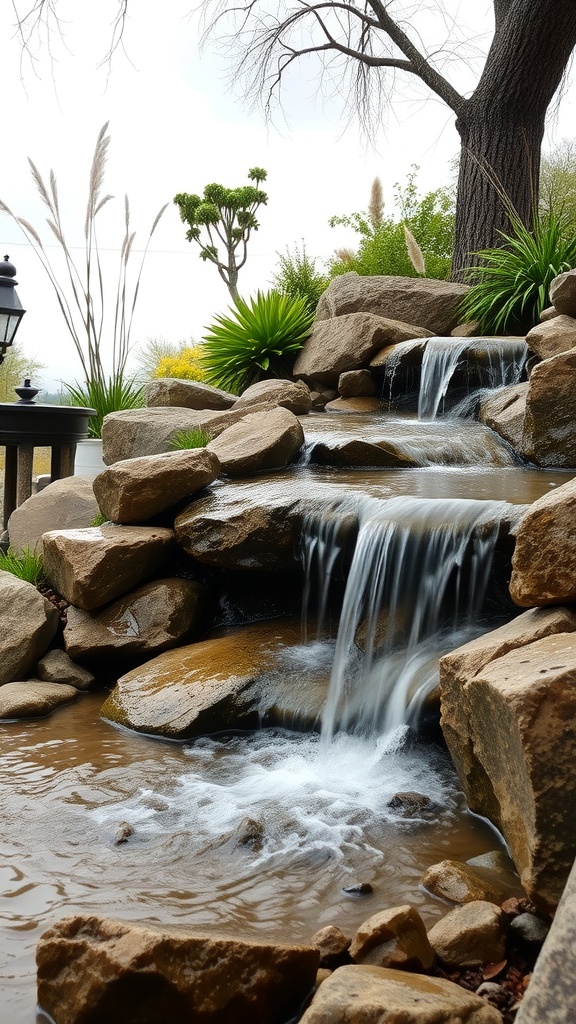
Water features can truly transform a sloped garden into a serene retreat. The gentle sound of flowing water creates a calming atmosphere, making it a perfect spot for relaxation. In the image, a beautiful waterfall cascades over rocks, adding a natural touch to the landscape.
Incorporating a water feature like this can enhance the visual appeal of your garden. The rocks and plants surrounding the waterfall provide texture and contrast, making the space feel more dynamic. You can choose from various styles, whether it’s a simple fountain or a more elaborate pond.
Besides aesthetics, water features can attract wildlife, such as birds and butterflies, bringing life to your garden. They also help with drainage in sloped areas, preventing erosion and keeping your plants healthy. Overall, adding a water feature is a fantastic way to elevate your sloped garden design.
Choosing the Right Plants for Slopes
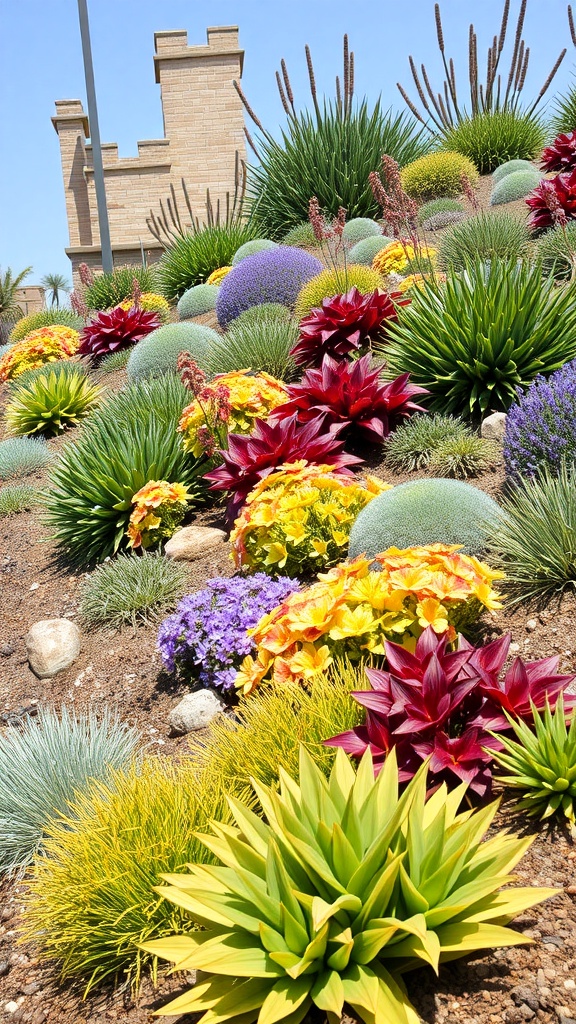
When designing a sloped garden, selecting the right plants is key. The image shows a vibrant array of plants thriving on a slope, showcasing how color and texture can create a stunning landscape. The mix of succulents, flowering plants, and ornamental grasses not only looks great but also serves practical purposes.
Plants that are drought-resistant and have deep root systems are ideal for slopes. They help prevent soil erosion and retain moisture. In the image, you can see various succulents and colorful flowers that are well-suited for such conditions. These plants can handle the challenges of a sloped environment while adding beauty.
Consider using a variety of heights and colors to create visual interest. The layered look in the image, with taller plants at the back and shorter ones in front, draws the eye and makes the garden feel more dynamic. Grouping plants with similar water and sunlight needs will also make maintenance easier.
Incorporating native plants can be beneficial too. They are adapted to the local climate and soil, making them easier to care for. The image illustrates how a thoughtful selection of plants can transform a slope into a vibrant garden that is both functional and beautiful.
Implementing Terracing Techniques
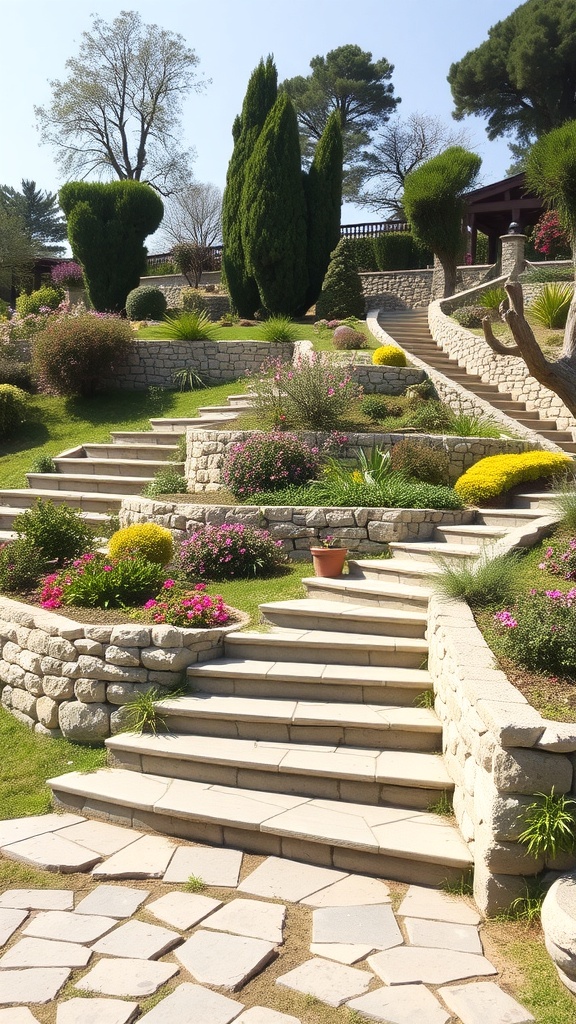
Creating a sloped garden can be a fun project, and terracing is a fantastic way to manage that slope. The image shows a beautifully designed terraced garden with steps leading up through various levels. Each level is adorned with vibrant flowers and greenery, making it visually appealing.
Terracing helps to prevent soil erosion and allows for better water drainage. The stone walls in the image not only provide structure but also add a rustic charm. The steps make it easy to navigate the garden, inviting you to explore each section.
Incorporating different plants at each level can create a layered effect. You can mix perennials with shrubs and ornamental grasses for variety. The colorful flowers in the image highlight how effective this can be.
Consider adding seating areas at different levels to enjoy the view. The terraced design encourages you to take a moment to relax and appreciate your hard work. With careful planning, your sloped garden can become a stunning outdoor space.
Understanding the Benefits of Sloped Gardens
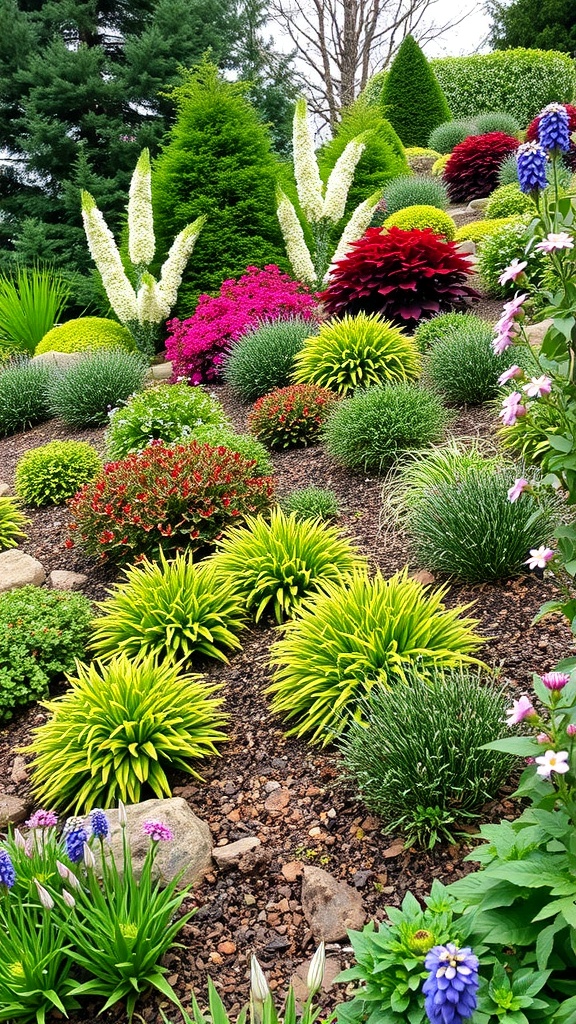
Sloped gardens can be a beautiful addition to any home. They offer unique opportunities for creativity and design. In the image, we see a couple strolling through a vibrant sloped garden filled with colorful flowers and lush greenery. The varied heights of the plants create a dynamic visual appeal.
One major benefit of sloped gardens is their ability to manage water runoff. The slope allows rainwater to flow naturally, reducing the risk of flooding. This can help keep your garden healthy and thriving.
Another advantage is the potential for creating distinct planting zones. Different plants can thrive at various heights, allowing for a diverse range of flora. This can attract various pollinators, enhancing the ecosystem in your garden.
Moreover, sloped gardens can provide a stunning view from different angles. As seen in the image, the layered plants create depth and texture, making the garden visually interesting. This can turn an ordinary space into a picturesque retreat.
Finally, sloped gardens can be easier to maintain. The natural drainage helps prevent waterlogging, which can be a common issue in flat gardens. This means less work for you in the long run!
Enhancing Soil Stability with Ground Covers
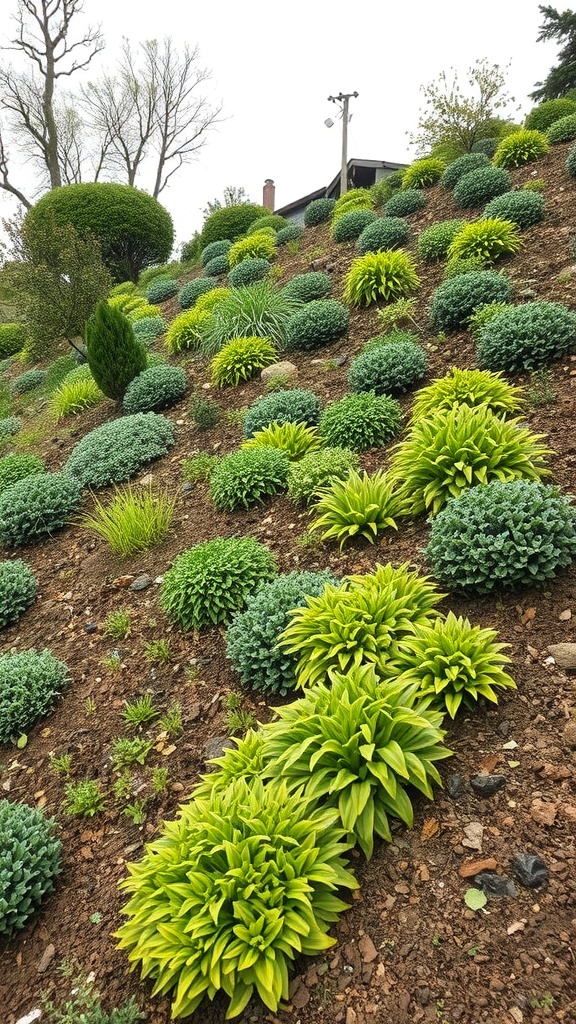
Creating a sloped garden can be a fun project, but it comes with its own set of challenges. One of the biggest concerns is soil stability. Ground covers play a key role in keeping the soil in place. The image shows a beautifully designed sloped garden filled with various ground cover plants.
The lush greenery in the photo highlights how effective these plants can be. They spread out and form a dense mat, which helps to prevent erosion. This is especially important on slopes where rain can wash away loose soil. The different shades of green add visual interest, making the garden not just functional but also attractive.
Using ground covers like the ones in the image can also improve soil health. They provide shade to the soil, reducing evaporation and keeping it moist. This is beneficial for the plants and helps maintain a balanced ecosystem in your garden. Plus, they require less maintenance once established, allowing you to enjoy your garden without constant upkeep.
Incorporating ground covers into your sloped garden design is a smart choice. They not only enhance the beauty of the space but also contribute to a healthier and more stable environment. So, if you’re planning a sloped garden, think about adding these wonderful plants!
Creating Microclimates on Slopes
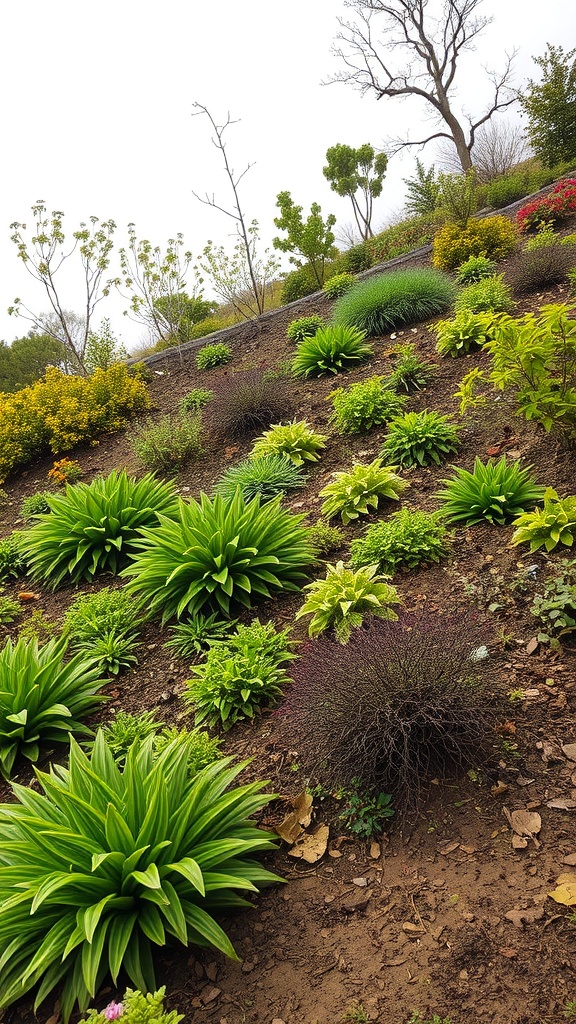
Sloped gardens can be a fantastic way to create unique microclimates. The image shows a vibrant sloped garden filled with various plants. Each plant thrives in its own little spot, showcasing how different areas can have different growing conditions.
On a slope, sunlight and wind patterns vary. The top of the slope might get more sun, while the bottom could be shadier and cooler. This means you can plant a mix of sun-loving and shade-tolerant plants. The lush greenery in the image highlights this diversity beautifully.
Using the slope to your advantage can lead to a thriving garden. For example, you might choose drought-resistant plants at the top where drainage is better, while moisture-loving plants can flourish lower down. This thoughtful arrangement helps each plant get what it needs.
Creating pathways or terraces can also help manage water flow and make maintenance easier. The layered look in the image emphasizes how different heights and textures can add interest and beauty to your garden. With a bit of planning, your sloped garden can become a stunning and functional space.
Incorporating Edible Plants in Sloped Designs
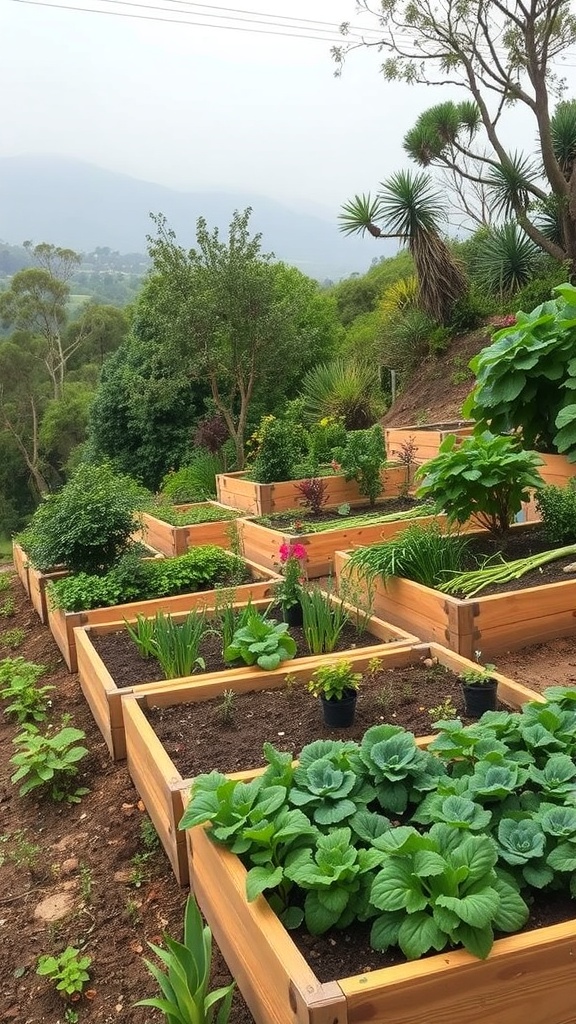
Creating a sloped garden can be a fun and rewarding project. The image shows a beautifully arranged sloped garden filled with raised beds. Each bed is bursting with a variety of edible plants, making the garden both functional and visually appealing.
Raised beds are perfect for sloped areas. They help with drainage and make it easier to manage soil quality. In this garden, you can spot leafy greens, herbs, and colorful flowers that attract pollinators. This mix not only adds beauty but also supports a healthy ecosystem.
When planning your own sloped garden, think about what you love to eat. Consider planting vegetables like lettuce, spinach, or even tomatoes. Herbs like basil and parsley can thrive in these beds too. They are easy to care for and can be used in your kitchen.
Don’t forget to include some flowers. They can help with pollination and add a pop of color. Plus, they can attract beneficial insects that keep pests away. This garden shows how you can create a balance between beauty and productivity.
Overall, incorporating edible plants into your sloped garden design can lead to a thriving space that provides fresh produce and enhances your outdoor experience.
Creating Wildlife Habitats in Sloped Gardens
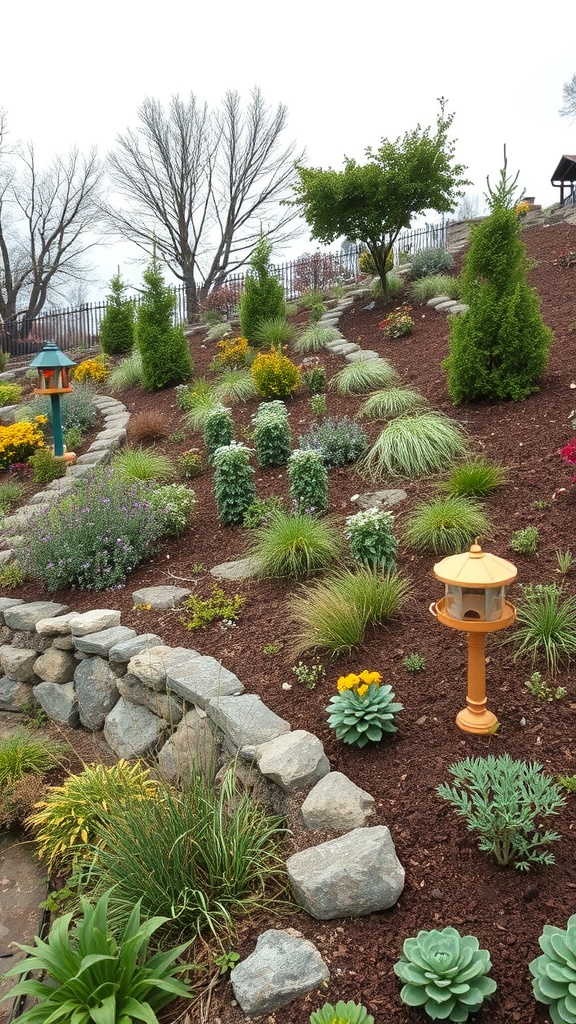
Sloped gardens can be a fantastic space for wildlife. The image shows a beautifully arranged sloped garden filled with various plants and features that attract different species. The colorful flowers and greenery create a lively environment.
One way to enhance this habitat is by adding native plants. These plants are well-suited to the local climate and soil, making them easier to maintain. They also provide food and shelter for local wildlife.
Incorporating features like bird feeders, as seen in the image, can draw in birds and other creatures. The stone wall not only adds charm but also creates different levels for animals to explore. This diversity in height is great for various species.
Another idea is to include small water sources. A birdbath or a small pond can be a refreshing spot for wildlife. It encourages birds and insects to visit, adding life to the garden.
Mulch, like the one shown in the image, helps retain moisture and provides a habitat for beneficial insects. These insects play a vital role in pollination and pest control.
Creating a sloped garden with wildlife in mind can be rewarding. It not only beautifies your space but also supports local ecosystems.
Adding Decorative Elements to Elevate Design
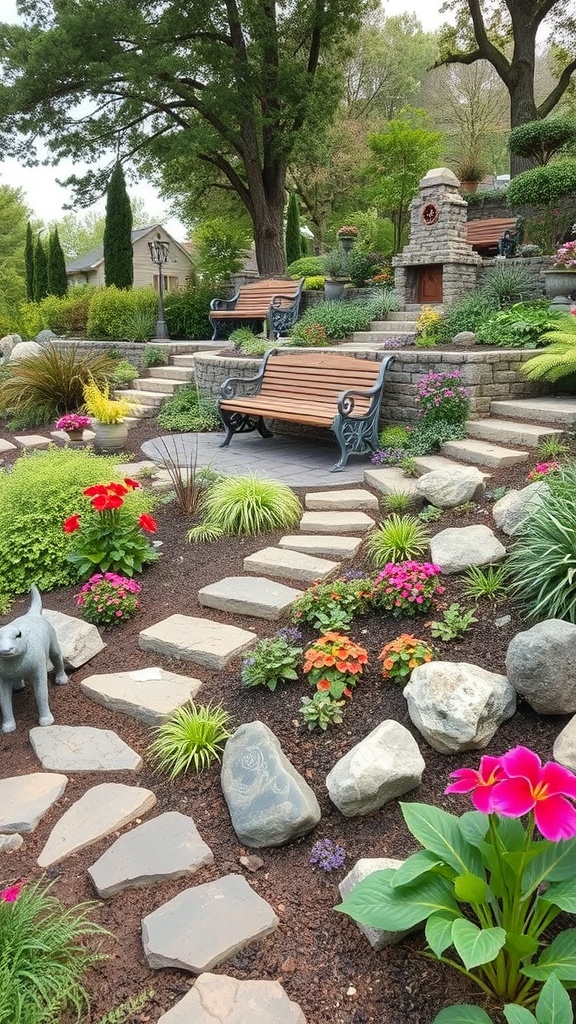
Creating a sloped garden can be a fun project, especially when you add decorative elements that bring the space to life. The image showcases a beautifully designed garden with a variety of features that enhance its charm.
The steps leading up to the house are framed by lush greenery and colorful flowers, creating a welcoming path. Statues and decorative benches invite visitors to pause and enjoy the view. These elements not only add visual interest but also provide spots for relaxation.
A striking feature is the fountain with a unique design, which acts as a focal point. The vibrant blue pot adds a pop of color, contrasting nicely with the greenery. Incorporating such elements can transform a simple garden into a delightful retreat.
Consider using a mix of textures and colors to create a dynamic look. Whether it’s through sculptures, planters, or seating areas, each piece contributes to the overall aesthetic. This approach makes the garden feel more cohesive and thoughtfully designed.
Incorporating Outdoor Living Spaces
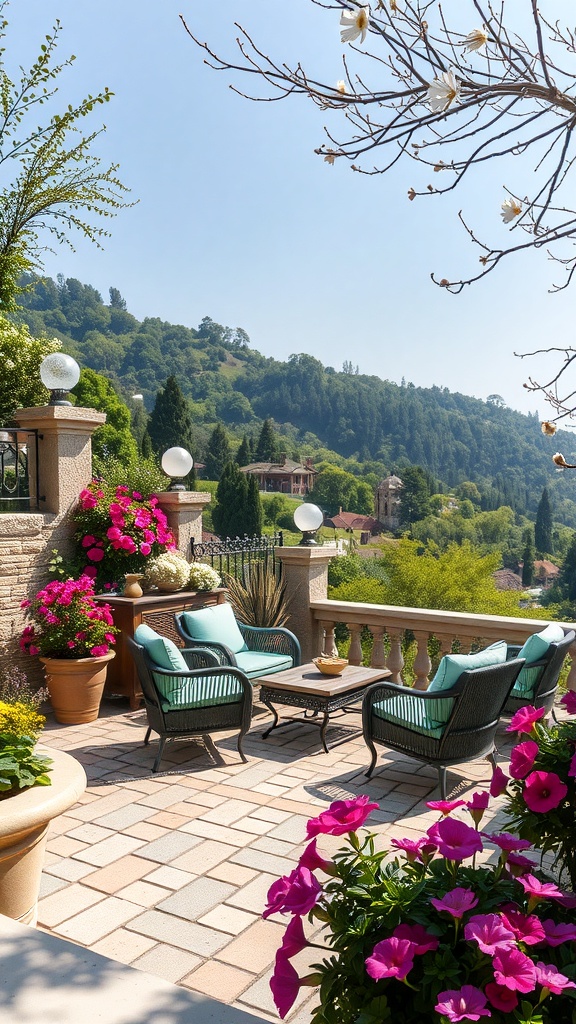
Creating a sloped garden can be a fun challenge, especially when it comes to adding outdoor living spaces. The image showcases a lovely patio area that beautifully blends comfort with nature. The seating arrangement invites relaxation, making it a perfect spot for morning coffee or evening chats.
The vibrant flowers in pots add a splash of color and life to the space. They not only enhance the visual appeal but also create a welcoming atmosphere. Incorporating plants into your outdoor design can make a big difference in how the space feels.
The layout of the patio is practical, with easy access to the surrounding garden. This design encourages you to enjoy the beauty of the sloped landscape while providing a cozy area to unwind. Whether you’re hosting friends or enjoying a quiet moment, having a well-planned outdoor space is key.
Utilizing Natural Stone for Pathways and Walls
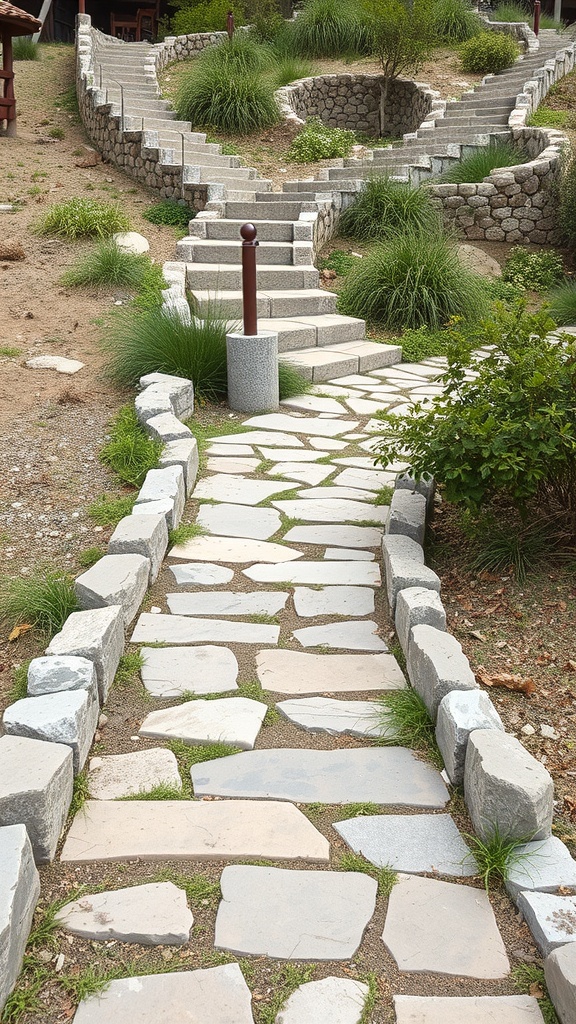
Natural stone can bring a unique charm to sloped garden designs. The image showcases a beautiful pathway made from various stone pieces, creating a rustic yet inviting feel. These stones not only serve as a functional path but also enhance the overall aesthetic of the garden.
The winding pathway leads through lush greenery, making it a perfect fit for a sloped area. The stones are arranged in a way that allows for easy walking while blending seamlessly with the natural surroundings. This design choice highlights the beauty of the landscape while providing a practical route through the garden.
Using stone for walls can also add structure to your garden. The image hints at stone walls that help retain soil on the slope, preventing erosion. These walls can be both functional and decorative, offering a sturdy backdrop for plants and flowers.
Incorporating natural stone into your garden design not only enhances its beauty but also promotes sustainability. Stones are durable and require little maintenance, making them a smart choice for any outdoor space.
Designing with Seasonal Interest in Mind

Creating a sloped garden can be a fun way to showcase seasonal beauty. The image captures a vibrant display of flowers and greenery, making it clear that thoughtful planning can lead to a stunning landscape.
In this garden, a mix of colorful blooms and lush foliage brings life to the slope. The variety of plants ensures that there’s always something to enjoy, no matter the season. For instance, early spring flowers can give way to summer blooms, followed by fall foliage that adds warmth to the landscape.
When designing your own sloped garden, think about layering plants. Taller varieties can be placed at the back, while shorter ones fill in the front. This not only creates depth but also allows each plant to shine. Consider using perennials for long-lasting interest, paired with annuals for seasonal pops of color.
Don’t forget about texture! Mixing different leaf shapes and sizes can add visual interest throughout the year. Evergreen plants can provide structure even in winter, ensuring your garden looks good year-round.
Incorporating Shade and Sun Areas
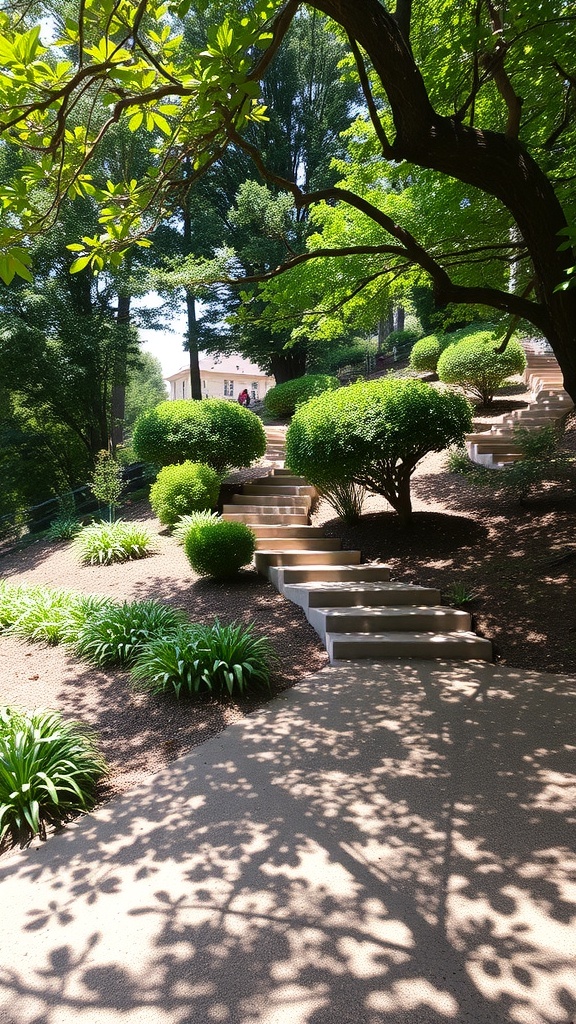
Creating a sloped garden can be a fun way to play with different light conditions. The image shows a lovely pathway winding through lush greenery, with steps leading up the slope. This design allows for both shaded and sunny spots, making it perfect for a variety of plants.
In the shaded areas, you can plant ferns or hostas that thrive in lower light. These plants add texture and depth to your garden. The sunny spots, on the other hand, are great for colorful flowers or herbs that need more sunlight to flourish.
Using the natural slope of the garden helps to create a dynamic space. The steps not only provide access but also break up the garden into different zones. Each zone can have its own unique plant life, making the garden more interesting and visually appealing.
Don’t forget to consider how the sunlight moves across your garden throughout the day. This will help you decide where to place your plants for the best growth. Balancing shade and sun areas will create a thriving environment for your garden.
Using Color and Texture for Visual Impact
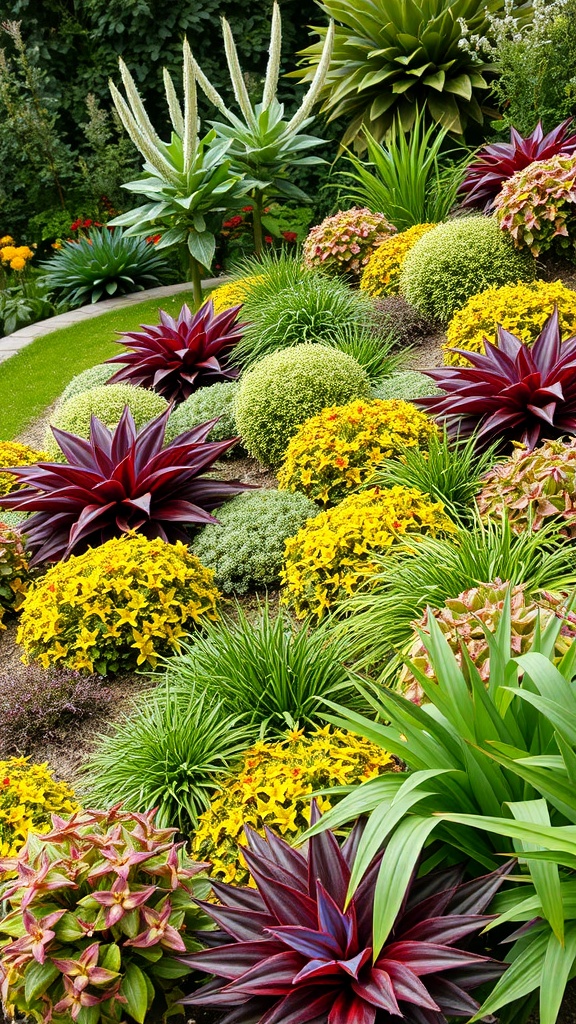
Creating a sloped garden can be a fun way to play with color and texture. The image shows a vibrant mix of plants that really brings the space to life. Bright yellows, deep reds, and lush greens create a stunning visual display.
The round, fluffy shapes of the yellow flowers contrast beautifully with the sharp, spiky leaves of the larger plants. This variety in texture adds depth to the garden, making it more interesting to look at. The different heights of the plants also help to create layers, drawing the eye across the garden.
Using bold colors can make a garden feel cheerful and inviting. The bright yellow flowers pop against the darker foliage, creating a lively atmosphere. Choosing plants with different textures, like the smooth leaves of the grasses and the rougher surfaces of the succulents, can enhance this effect even more.
In a sloped garden, it’s important to think about how these colors and textures will interact as you view them from different angles. This image showcases how thoughtful plant selection can transform a simple slope into a captivating landscape.
Embracing Natural Slopes in Landscape Design

Sloped gardens can bring a unique charm to any landscape. The image shows rolling hills, dotted with greenery and a cozy house nestled at the base. This setting highlights how natural slopes can enhance the beauty of a garden.
Using the natural contours of the land can create a stunning visual effect. The gentle slopes in the image allow for varied plant life, which can add texture and color to the garden. Trees and shrubs thrive in these areas, providing shade and a habitat for wildlife.
Incorporating pathways, like the winding road seen in the image, can make the garden more accessible. These paths invite exploration and can lead to different areas of the garden, making it a delightful experience for visitors.
When designing a sloped garden, consider using terraces or retaining walls. These features can help manage water runoff and create flat areas for planting. The lush greenery in the image shows how effective these methods can be in creating a vibrant landscape.
Planning for Maintenance and Accessibility
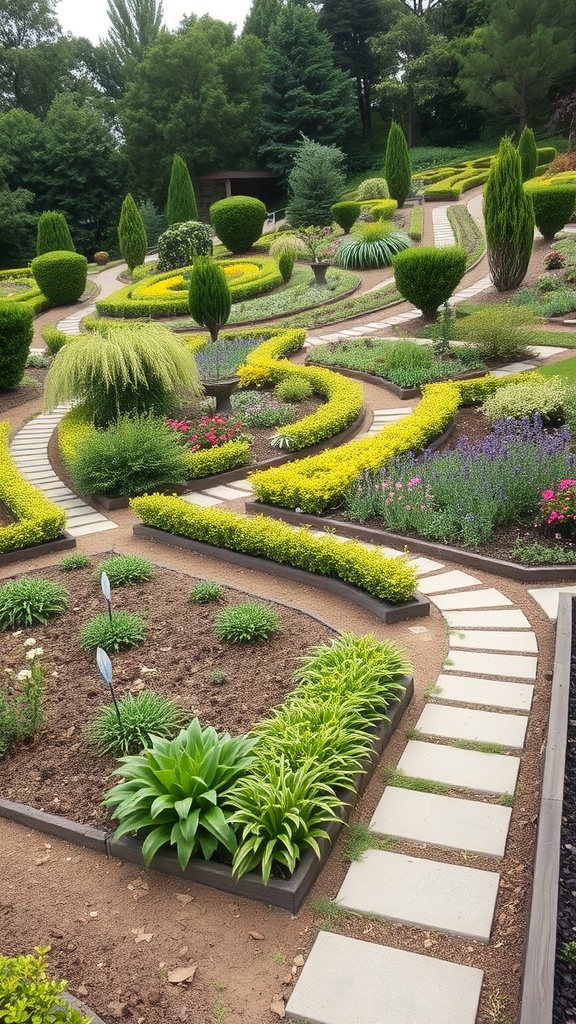
When designing a sloped garden, maintenance and accessibility are key factors to keep in mind. The image shows a beautifully arranged garden with winding paths and vibrant plants. This layout not only looks appealing but also promotes ease of movement.
Creating clear pathways, like the stone steps in the image, helps ensure that you can easily navigate the garden. These paths allow you to reach different areas without disturbing the plants. It’s important to choose materials that are slip-resistant, especially on slopes.
Regular maintenance is essential for keeping a sloped garden looking its best. Consider using plants that require less upkeep. Native plants often thrive with minimal care and can adapt well to the local environment. This can save you time and effort in the long run.
Incorporating features like terracing can also help with maintenance. Terraces create flat areas that are easier to manage and can prevent soil erosion. This is especially useful in a sloped garden where water runoff can be an issue.
Lastly, think about accessibility for everyone. Wide paths and gentle slopes can make the garden enjoyable for all visitors. This way, everyone can appreciate the beauty of your sloped garden without any barriers.
